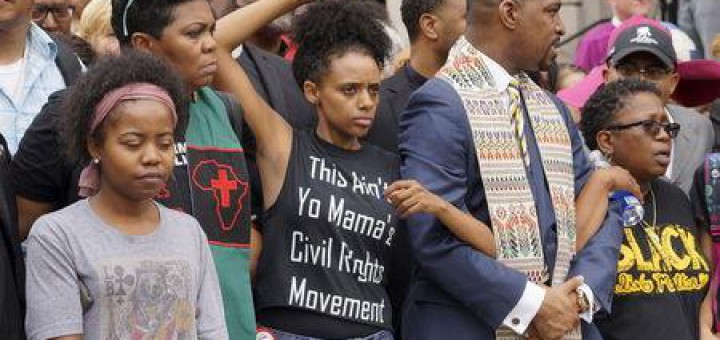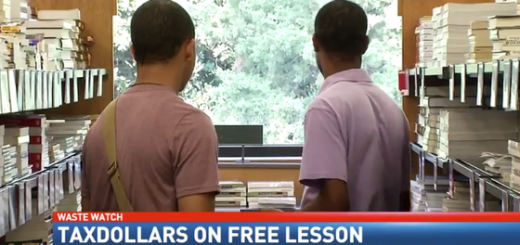St. Louis County police said a gun battle in Ferguson, Mo. late Sunday climaxed when one of the suspects involved opened fire on plainclothes detectives before being pursued and shot by the officers after a day of peaceful demonstrations in Ferguson marking the anniversary of Michael Brown’s death.
Chief Jon Belmar did not identify the suspect, whom he said was in “critical, unstable” condition at a local hospital. However, the St. Louis Post-Dispatch identified the man as 18-year-old Tyrone Harris Jr. Harris’ father, also named Tyrone, told the paper that his son had just come out of surgery early Monday, and noted that his son and Brown “were real close.”
In a statement released Monday morning, St. Louis County police said the suspect was one of at least two people who exchanged gunfire at around 11:15 p.m. local time along West Florissant Avenue. Belmar said that between 40 and 50 shots were fired in an exchange that lasted approximately 45 seconds, an amount he described as “remarkable.”
Belmar said that officers had been tracking the suspect, whom they believed to be armed, during the protest. As the gunfire began, the unmarked van the officers were driving in turned on its emergency lights and began moving toward the suspect. Authorities said the man opened fire, striking the van multiple times.
The officers returned fire from inside the vehicle before pursuing the man on foot. Belmar said the man then shot again at the officers, all four of whom returned fire.
The suspect had a semi-automatic 9MM gun that was stolen last year from Cape Girardeau, Missouri, according to the chief.
The officers have been placed on administrative leave, in keeping with standard practice after police-involved shootings. Belmar said none of the officers, who have between 6 and 12 years of experience, was seriously injured.
“They were criminals. They weren’t protesters,” Belmar said of those involved in the gun battle.
“There is a small group of people out there that are intent on making sure that peace doesn’t prevail,” he added. “There are a lot of emotions. I get it. But we can’t sustain this as we move forward.”
At the time of the violence, observers told the Post-Dispatch that fewer than 100 protesters remained on the streets and were outnumbered by members of the media. However, the few protesters who remained were blocking traffic and confronting police. One person threw a glass bottle at officers but missed.
For the first time in three consecutive nights of demonstrations, some officers were dressed in riot gear, including bullet-proof vests and helmets with shields. One officer was treated for cuts related to a brick thrown at his face, Belmar said. Police made an unknown number of arrests and at one point early Monday shot smoke to disperse the crowd that lingered on West Florissant, he said.
The gunfire marred a day of largely peaceful protest on the anniversary of the killing that shone a national spotlight on relations between the police and black communities across America. Brown’s father, Michael Brown Sr., led a march through town after a crowd of hundreds observed 4 1/2 minutes of silence.
The group began their silence at 12:02 p.m., the time Brown was killed, for a length of time that symbolized the 4 1/2 hours that his body lay in the street after he was killed. Two doves were released at the end.
The elder Brown then held hands with others to lead the march, which started at the site where his son, who was black and unarmed, was fatally shot by Ferguson officer Darren Wilson on Aug. 9, 2014. A grand jury and the U.S. Department of Justice declined to prosecute Wilson, who resigned in November, but the shooting touched off a national “Black Lives Matter” movement.
Pausing along the route at a permanent memorial for his son, Michael Brown Sr. said, “Miss you.”
He had thanked supporters before the march for not allowing what happened to his son to be “swept under the carpet.”
Later, a few hundred people turned out at Greater St. Mark Family Church for a service to remember Brown, with his father joining other relatives sitting behind the pulpit. Anthony Gray, a Brown family attorney pressing a wrongful-death lawsuit against Ferguson, Wilson and his former police chief, suggested that justice will be served on Michael Brown’s behalf.
Gray told the crowd: “You knew in your gut that (the shooting) wasn’t right. And you knew what that officer did was unjustified.”
The two-hour commemoration, featuring a mime dance and a rap-infused version of “Lean on Me” peppered between reflections about Brown, thinned as it wore on. Roughly 50 still remained by the time Michael Brown Sr. was finally handed the microphone to thank attendees and close out the event, saying, “This movement is going to be a good movement.”
Organizers of some of the weekend activities have pledged a day of civil disobedience on Monday, but have not yet offered specific details.
Earlier, at the march, some wore T-shirts with likenesses of Brown or messages such as “Please stop killing us” or “Hands up! Don’t shoot!” which became a rallying cry during the sometimes-violent protests that followed the shooting a year ago.
But the focus of the weekend has largely been on Brown, who graduated from high school weeks before the shooting and planned to go to trade school to study to become a heating and air conditioning technician.
Relatives and friends described Brown as a quiet teen who stood around 6-foot-3, weighed nearly 300 pounds and was eager to start technical college. But police said Brown stole items from a convenience store and shoved the owner who tried to stop him on the morning of Aug. 9, 2014. Moments later, he and a friend were walking on Canfield Drive when Wilson, who is white, told them to move to the sidewalk.
That led to a confrontation inside Wilson’s police car. It spilled outside, and Wilson claimed that Brown came at him, menacingly, leading to the fatal shooting. Some witnesses claimed Brown had his hands up in surrender. Federal officials concluded there was no evidence to disprove testimony by Wilson that he feared for his safety, nor was there reliable evidence that Brown had his hands up in surrender when he was shot.
The shooting led to protests, some violent, and the unrest escalated again in November when a St. Louis County grand jury determined that Wilson did nothing wrong. He resigned days later. The November riots included fires that burned more than a dozen businesses.
The Justice Department reached the same conclusion in March, clearing Wilson. But in a separate report, the Justice Department cited racial bias and profiling in policing as well as a profit-driven municipal court system that often targeted black residents, who make up about two-thirds of Ferguson’s populace.
Ferguson’s city manager, police chief and municipal judge resigned within days of that report. All three were white. The new judge, interim city manager and interim police chief are all black.
The Associated Press contributed to this report.
Click for more from the St. Louis Post-Dispatch.
Source: FOXNews.com














Recent Comments